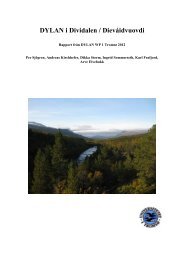Guide to identification of Lumbrineridae (Polychaeta) - NTNU
Guide to identification of Lumbrineridae (Polychaeta) - NTNU
Guide to identification of Lumbrineridae (Polychaeta) - NTNU
Create successful ePaper yourself
Turn your PDF publications into a flip-book with our unique Google optimized e-Paper software.
<strong>Lumbrineridae</strong> in Norwegian and adjacent waters 14<br />
Lumbrineriopsis Orensanz, 1973<br />
Characteristics. Parapodia uniramous, with simple limbate chaetae and simple bidentate hooded<br />
hooks. Aciculae yellow or black. Mx III with two aliform expansions. Mx IV finely denticulate.<br />
Pygidium rounded.<br />
Taxonomy. The genus is characterised by the presence <strong>of</strong> bidentate hooded hooks and the shape <strong>of</strong> the<br />
maxillae. The genus was revised by Miura (1980). Four species are known from NE Atlantic waters.<br />
1. Black aciculae, hooded hooks with 2-5 needle-shaped denticles between the two main teeth<br />
...................................................... Lumbrineriopsis tsushimaensis Imajima & Higuchi, 1975<br />
North Sea<br />
Figs from left: anterior end; bidentate<br />
hook chaetiger 8; bidentate hook<br />
posterior chaetiger. From Imajima &<br />
Higuchi (1975).<br />
- Yellow aciculae, hooded hooks with an open space between the teeth ................................ 2<br />
2. Pros<strong>to</strong>mium prolonged ……………..……. Lumbrineriopsis paradoxa (Saint-Joseph, 1888)<br />
France, English Channel, shallow water<br />
Figs from left: anterior end; parapodium<br />
from middle body; bidentate hook;<br />
maxillae. From Miura (1980).<br />
- Pros<strong>to</strong>mium short, slightly longer than wide ...........................................................................<br />
............................................................. Lumbrineriopsis sp. (L. paradoxa sensu Fauvel 1923)<br />
France, English Channel, shallow water<br />
Figs from left: anterior end; limbate<br />
chaeta; bidentate hook; maxillae. From<br />
Fauvel (1923).





